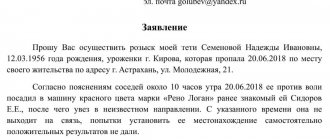It is necessary to understand the difference between hostage taking and kidnapping in order to correctly classify the crime and assign the appropriate punishment.
Determining the composition of a specific offense often causes certain difficulties, especially when the external signs of criminal acts coincide. Taking a hostage, like kidnapping, involves illegally depriving a citizen of freedom of movement and holding him in captivity. Outwardly, both actions are very similar. How to distinguish one from the other? To resolve this issue, it is necessary to examine in detail the articles of the Criminal Code corresponding to the offenses in order to identify the characteristics of each offense.
Multi-channel free hotline Legal advice on criminal law. Every day from 9.00 to 21.00
Moscow and region: +7 (495) 662-44-36
St. Petersburg: +7 (812) 449-43-40
Capture and abduction: why is it difficult to differentiate?
The Criminal Code of the Russian Federation is a collection of articles that characterize illegal actions from various aspects and describes possible punishments for their commission.
- subject of the crime;
- object of crime;
- the objective side of the crime, that is, the very actions of violating the established law;
- the subjective side of the crime, that is, the goals pursued by the offender, the motives of his actions, guilt or lack thereof.
The combination of these four factors constitutes the crime. It is possible to distinguish one crime from another if we consider all their constituent parts. Comparison based on only one characteristic does not allow us to draw reliable conclusions.
For example, to answer the question of what is the difference between kidnapping and seizure, it is necessary to evaluate the side, which legal scholars call subjective, and the object of the illegal action. The fact is that the other two aspects of these offenses are practically indistinguishable.
The subject of the crime in both situations is a person who is recognized as sane and has reached the age of fourteen years.
- A person is captured by a subject against his will.
- He is kept there regardless of his intentions.
- It can be forcibly moved to another location at the request of the subject.
The only and insignificant difference is that when captured, a demand is always made to a third party.
- may be absent;
- to be nominated to relatives or close people (for example, ransom);
- may be presented to the abducted person himself.
In response to the question of how kidnapping differs from hostage-taking, some legal scholars who study this issue say that if demands are made, kidnapping would be a type of hostage-taking. However, most comments claim that this is still a kidnapping for a specific purpose, for example, to obtain a ransom. This position is more justified, as follows from a detailed consideration of the subjective side of criminal actions.
Object, subject and subjective side
What is being encroached upon, that is, any social relations, is the object of a crime. In the event of hostage taking, they will be represented by such an element as public safety. For example, the taking of hostages by terrorists implies the goal of intimidation and obtaining some benefit from the state. This is considered a distinctive feature of this type of crime.
The subject, that is, the one who committed a socially dangerous act, is always common. A physically sane person who has reached a certain age is the subject. The only thing that may differ is the last requirement, that is, age, which in some cases may even be lower than 16 years. Hostage-taking is an act for which a person who has reached fourteen years of age is held accountable.
The subjective side is always guilt, that is, the attitude of the criminal to what he does and the consequences of these actions. When taking hostages, it always manifests itself in the form of direct intent and does not imply negligence. This is the reason why this act is considered particularly dangerous.
Distinctive features of a crime
Taking hostages in order to force them to fulfill any demands is no longer a rarity; it is recognized today as a crime of an international nature.
The fight against it is being carried out in all countries. This is one of the most common criminal ways to seek benefits for oneself from the state or individual organizations.
Taking a hostage looks like holding a person against his will. Due to the actions of the criminal, a citizen cannot, for example, leave the premises on his own, as he is tied up or threatened with a weapon. However, this is not the purpose of the crime.
- nationalist;
- racial;
- political;
- and others.
Sometimes they may seem absurd or impossible to implement (for example, establishing a form of government such as a republic).
But at the same time, government agencies are forced to act in the interests of people held hostage. This is what criminals are counting on, because in most cases they know perfectly well what they want. For example, two prisoners are captured and held against the will of the warden.
- provide them with a car;
- provide the opportunity to leave prison early;
- provide conditions so that they can leave the city.
They do not want to harm their hostage and are willing to release him if their demands are met. However, if necessary, criminals are ready to take extreme measures. And even murder.
The main task of the offender is to achieve the fulfillment of certain of his desires. For this purpose, the criminal openly announces that such and such a person or several citizens are being held hostage by him. Moreover, he threatens to keep them further or harm them, even kill them, if his demands are not met.
The object of hostage-taking is not the interests of any individual citizen, but the security of society as a whole. And although it is the hostage who suffers first of all, in this case legislators classify him as an additional object of attack.
The fact is that the criminal does not intend to cause trouble for a specific person.
It is important to understand the purpose and motives of this crime, as well as to understand what is the guilt of the lawbreaker.
- The presence of direct intent (that is, a planned seizure of a person and his forcible detention in order to demand the execution of actions necessary for the criminal or, conversely, the failure to perform some actions).
- The presence of a special goal, which is to force the state or organization to fulfill the demands made by the invader.
It is the purpose and object of the crime of capture that distinguishes it from kidnapping.
Qualifying features
Aggravating circumstances entail the imposition of a higher penalty. Art. 206 of the Criminal Code of the Russian Federation records an exhaustive list of those cases when the taking of hostages is considered committed in the presence of the factors mentioned above. So, these include crimes committed:
- out of self-interest;
- a group of persons;
- directed at a pregnant woman or in relation to two or more persons;
- causing death or serious harm, either through negligence or intentionally;
- using violence or weapons;
- in relation to a person who has not reached the age of majority.
This list of acts that are considered aggravating circumstances is important when assigning punishment, and also allows us to identify the difference between hostage-taking and kidnapping.
Kidnapping: Characteristics
Often in the modern world, law enforcement officers are faced with kidnapping, that is, the kidnapping of citizens.
To appreciate the kidnapping of a person and its difference from the taking of a person hostage, it is necessary to comprehend the possible goals of such an act. Externally, this crime also represents the forcible detention of a person and deprivation of his ability to move freely, as well as his movement in the area against the will of the victim.
The main intention of the criminal: to kidnap and hold a person in a certain place for the required time. This is the main purpose of this offense.
It becomes quite clear that the object of criminal activity is the interests of a particular person, an encroachment on his freedom, which is guaranteed to every citizen of the country.
- direct intent (to restrict the freedom of another person for one’s own purposes, ransom, blackmail, etc.);
- the presence of motives (the subject has reasons why he commits a crime);
- a clear goal (elimination for some time or forever of a person from a certain environment, without implying harm to him or his death).
Thus, abduction is associated with a specific person, with his physical elimination (not death). The criminal needs this for some purpose.
Sometimes these goals, from an everyday point of view, can be justified. For example, a neighbor owes you a large sum and does not want to pay you back. You kidnap him and keep him locked up at your dacha, while demanding repayment of the debt. In general, the desire of the criminal is quite understandable. However, from the point of view of the law, kidnapping a person is wrong. The legislator considers such actions to be criminal and imply criminal liability.
Sometimes, when kidnapping a person, the subject pursues the goal of inflicting severe beatings on him or wants to kill him.
In this case, the act will not be qualified under Article 126 of the Criminal Code, since “pure” kidnapping does not involve causing harm to health.
An example of actions that the legislator classifies as kidnapping is the following situation. One of the researchers learns that his colleague found the answer to a complex scientific problem before him. He decides to eliminate his opponent for a while.
- Taking possession of the results of a scientific discovery.
- Providing them to the public as their own achievement.
- The desire to gain time to solve the problem yourself and act as a pioneer.
The main point is that no physical harm is intended. There is also no goal to demand something from the state.
Problems of qualification of crimes under Art. 126 and 206 of the Criminal Code of the Russian Federation
The question of how to correctly evaluate from a legal point of view the actions of a particular suspect in order to obtain the corpus delicti arises quite often when it is necessary to understand the difference between hostage-taking and kidnapping. They are the ones who create the most difficulties for law enforcement officers.
Qualifying a crime is an important stage in transferring a case to court and further proceedings, since the correctly chosen norm implies the type of sanction and responsibility that the criminal will bear. It is quite easy to confuse the two crimes we are considering, since their elements are similar. However, to solve the existing problem, it is enough to accurately determine the object of the attack and some specific features of the act itself.
Other similarities and differences between kidnapping and hostage taking
Considering the kidnapping of a person, we see its difference from hostage-taking in the internal attitude of the criminal. The main thing is that they must be distinguished by the purpose and object of the offense. Other differences also follow from this.
Such a violation of the law is clearly punishable by imprisonment. The period, depending on the conditions, can vary from 5 to 10 years.
In the case of kidnapping, we should talk about an offense of moderate gravity. Punishment for it is imposed in the form of forced labor for a period of no more than five years. Or the court may impose a verdict of imprisonment for the same period.
- the abduction, as a rule, is carried out secretly and is not advertised; only close people know about it;
- the seizure is accompanied by the involvement of journalists and the public in general;
- capture is never limited to depriving him of his liberty.
These distinctions are also related to the purposes of the criminal acts.
In both cases, the legislator considers the voluntary refusal to further detain a person in captivity as an exemption from criminal liability if the acts were not accompanied by other offenses.
- Participation in a crime by a pre-organized group.
- When the person captured or kidnapped is a minor or a pregnant woman (only if the offender knew about these factors).
- Weapons or objects were used that could cause injury or damage to the victims.
- When criminals were driven by self-interest.
- Violence was used in the commission of the act.
- There were two or more victims.
In such cases, the punishment may be increased.
In the case of hostage taking - up to 15 years in prison (the crime becomes especially serious).
When the kidnapping is aggravated, the sanctions may be twelve years in prison followed by a subsequent limitation of up to two years.
Aggravating circumstances
Article 126 of the Criminal Code of the Russian Federation contains an exhaustive list of features that transform a simple crime into a qualified or especially qualified one. These include the commission of an act by a group of persons; with the use of violence; motivated by self-interest; in relation to a pregnant woman, two or more persons, a minor; resulting in the death of the victim, crimes committed through negligence and possibly causing serious harm to health.
This list is practically no different from what was presented when considering hostage taking. However, as you can see, in case of kidnapping there is no qualifying feature that would indicate premeditated murder. That is, the occurrence of death as an aggravating circumstance is recorded only when a hostage is taken.
Some collisions
Deprivation of freedom against a person’s will is a narrower concept than kidnapping:
- kidnapping consists of taking, moving, holding;
- deprivation of liberty consists only of detainment and restriction of freedom of movement.
The famous case of Viktor Mokhov, who held two women in his basement for several years, is indicative in terms of the distinction between kidnapping and unlawful imprisonment. Mokhov was found guilty of kidnapping two girls, 14 and 17 years old, who were placed by him in a basement and suffered several years of humiliation and abuse. Here we see that there was a movement of the victims to a place convenient for the criminal, where he kept them for his pleasures. At the same time, involuntary residence in a basement is not qualified separately; it is already covered by Article 126 of the Criminal Code of the Russian Federation, which provides for liability for kidnapping.
In judicial practice, some qualification problems are resolved ambiguously:
How long should unlawful imprisonment be?
The legislator does not provide a time period during which deprivation of the right to movement will be considered illegal. It is enough to carry out the corresponding actions against the will of a person. At the same time, a short-term restriction will likely be recognized as a minor crime and not causing any harm to the victim.
When is deprivation of liberty considered illegal?
It is clear that, according to the investigator’s decision, keeping the suspect under house arrest in a pre-trial detention center will be considered legal and, of course, does not fall under Article 127 of the Criminal Code of the Russian Federation. At the same time, if a mother does not allow her adult son to go outside, forcing him to do certain housework, will there be illegal imprisonment here? It is difficult to answer such a question, but if you read the law literally, theoretically there are signs of a crime.
Can kidnapping be legal and excluding liability?
No matter how strange it may seem, it can be non-criminal. So, according to the customs of some Caucasian peoples, it is necessary to kidnap her, sometimes she is not returned for several hours. In such cases, there is a note to Article 126 of the Criminal Code of the Russian Federation about the absence of liability of the perpetrator if he voluntarily handed over the stolen property (there is no such note in Article 127 of the Criminal Code of the Russian Federation). The legislator has not specified how long this extradition must take place.
Kidnapping
Unfortunately, this type of criminal activity is not uncommon. Moreover, such crimes are carefully planned long before they are committed and are almost never committed alone. It often happens that a kidnapped person knows his abductors by sight, which leads to sad consequences: in order to cover up traces and eliminate eyewitnesses, the victim is deprived of his life.
The very concept of “kidnapping” is more fully disclosed in theory than in criminal law - this term is not in Article 126 of the Criminal Code of the Russian Federation. Kidnapping (it can be either secret or open) is characterized by active actions of the participants, since the nature of the crime implies the capture of a person and moving him to another place where he is planned to stay for a certain time.
The classic kidnapping is the following example: A.V. Davydov, who unsuccessfully demands the return of the borrowed 500,000 rubles from V.V. Rebrov, decides to kidnap his son, the minor A.V. Rebrov. To do this, he agrees with his acquaintance P.R. Utesov, who has a car, to kidnap a child from the school and take measures to obtain a ransom of double the amount - 1 million rubles, 20% of the amount A.V. Davydov. promises accomplice V.V. Rebrov. Since Rebrov’s son V.V. knows Davydov A.V. personally. as a family friend, he has no fears about the “unexpected” meeting of him near the school, he voluntarily gets into the approaching car, after which Davydov A.V. and Utesov P.R. They take the child to a pre-rented apartment on the outskirts of the city, where they live for three days. During this time, the kidnappers periodically call the minor's father and demand a million rubles under the threat of causing the kidnapped person's death.
In this situation, we see typical signs of kidnapping within the meaning of criminal law:
- A man is captured against his will by intruders.
- The victim is moved to another location and held there.
It should be noted that in most cases, the actions of criminals are also qualified under other articles of the Criminal Code of the Russian Federation, since kidnapping alone without further intentions is rarely committed. Thus, in the above example, the actions of the perpetrators fall under the signs not only of Art. 126 of the Criminal Code of the Russian Federation, but also extortion with threats of violence.
The article in question contains a fairly large number of additional features provided for by the legislator in part two:
- when a crime is committed by several persons (by prior agreement, with the distribution of roles and a clear definition of the degree of participation of each);
- with violence or threats of its use (this is the symptom that most often “accompanies” the kidnapping of a person, since it serves as a way to suppress the resistance of the victim);
- when they use weapons or any objects instead of them (bats, sticks, clubs, etc.);
- if the weakest representatives of humanity are kidnapped: children, pregnant women;
- when the kidnapping is carried out against several (more than two) persons;
- if the motive for committing a crime is selfish.
These additional signs give the right to increase the punishment from five years of imprisonment (“simple kidnapping”) to twelve .
In addition, if the actions are committed by a criminal group or the victim died (due to negligence), then the perpetrator may be sentenced to 15 years of isolation .








